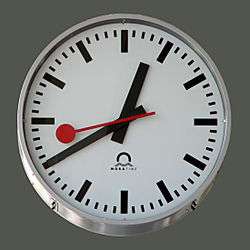Swiss Federal Railways
Swiss Federal Railways (German: Schweizerische Bundesbahnen, SBB; French: Chemins de fer fédéraux suisses, CFF; Italian: Ferrovie federali svizzere, FFS) is the national railway company of Switzerland. It is usually referred to by the initials of its German, French, and Italian names, either as SBB CFF FFS, or used separately. The Romansh version of its name, Viafiers federalas svizras, is not officially used.[1][2][3]
Native name | Schweizerische Bundesbahnen (German) Chemins de fer fédéraux suisses (French) Ferrovie federali svizzere (Italian) Viafiers federalas svizras (Romansh)[note 1] |
|---|---|
| Fully state-owned limited company (AG) regulated by public law | |
| Industry | Rail Transport |
| Founded | 1 January 1902 |
| Headquarters | , |
Key people | Vincent Ducrot, CEO |
| Revenue | |
| Total assets | CHF44.308 billion (2016) |
| Total equity | CHF12.005 billion (2016) |
Number of employees | 33,119 (2016, FTE) |
| Divisions | Passenger, SBB Cargo, Infrastructure, Real Estate |
| Website | sbb |
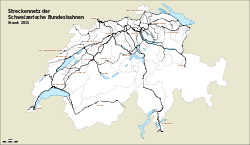 SBB network (for the whole Swiss railway network see: Rail transport in Switzerland) | |
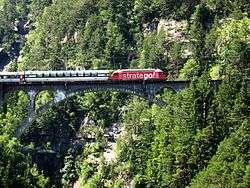 InterCity on the old Gotthard Line | |
| Overview | |
|---|---|
| Dates of operation | 1 January 1902–present |
| Technical | |
| Track gauge | 1,435 mm (4 ft 8 1⁄2 in) standard gauge |
| Electrification | 100% 15 kV, 16.7 Hz Overhead line |
| Length | 3,230 km (2,007.0 mi) |
The company is headquartered in Bern. It used to be a government institution, but since 1999 it has been a special stock corporation whose shares are held by the Swiss Confederation and the Swiss cantons.
SBB was ranked first among national European rail systems in the 2017 European Railway Performance Index for its intensity of use, quality of service, and safety rating.[4] While European rail operators such as French SNCF and Spanish Renfe have emphasised the building of high-speed rail, SBB has invested in the reliability and quality of service of its conventional rail network. In addition to passenger rail, SBB operates cargo and freight rail service and has large real estate holdings in Switzerland.
Organisation
Swiss Federal Railways is divided into three divisions and eight groups.[5] The divisions manage the relevant operational businesses. These divisions are:
- Passenger traffic
- Infrastructure
- Real estate
The former division Cargo became an independent group company at the start of 2019.
SBB's eight groups manage the company and support the operational business of the divisions with service and support functions. These groups are:
- Finance
- HR
- IT
- Communications
- Corporate Development
- Safety & Quality
- Legal and Compliance
- Supply Chain Management
The corporation is led in an entrepreneurial manner. A performance agreement between Swiss Federal Railways and the Swiss Confederation defines the requirements and is updated every four years. At the same time the compensation rates per train and track-kilometre are defined.
A subsidiary, SBB GmbH, is responsible for passenger traffic in Germany. It operates the Wiesentalbahn and the Seehas services. Other subsidiaries are THURBO, RegionAlps, AlpTransit Gotthard AG, Cisalpino, and TiLo (the latter in conjunction with Italian authorities). Swiss Federal Railways hold significant shares of the Zentralbahn and Lyria SAS.
The Stiftung Historisches Erbe der SBB ("SBB Historic") was founded in 2002. This foundation takes care of historic rolling stock and runs a technical library in Bern, document and photographic archives, and the SBB poster collection.
Figures
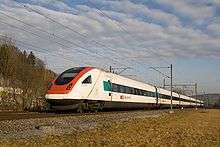
All figures from 2018:
- Length of railway network: 3,134 km in standard gauge and 98 km metre gauge[6]
- Percentage electrified routes: 100%[6]
- Employees: 32,309[7]
- Passengers carried per day: 1.25 million[8]
- Passenger-kilometer per inhabitant and year: 2,215 kilometres (1,376 mi)[8]
- Stations open to passengers: 795[6]
- Customer Punctuality: 90.1% of all passengers reached their destination - measured from departure station including any necessary changes - with less than 3 minutes of delay (either 2 or 1 minute delay, or on time)[9]
- Customer-weighted connection punctuality: 96.7%[9]
- Freight per year: 53.5 million tons[8]
- Stations with freight traffic: 193
- Railway tunnels: 321[6]
- Railway Tunnels total length: 388.5 kilometres (241.4 mi)[6]
- Longest Tunnel: 57.1 kilometres (35.5 mi) (Gotthard Base Tunnel) world record
- Railway Bridges: 6,015[6]
- Railway bridges total length: 105.9 kilometres (65.8 mi)[6]
- Electric multiple units (fixed compositions of power cars and coaches): 522[10]
- Power Cars: 121[10]
- Mainline locomotives: 648 (passenger services: 335 / freight services: 313)[10]
- Shunting locomotives: 222 (45/76/ infrastructure: 101)[10]
- Shunting tractors: 250 (22/39/189)[10]
- Passenger coaches: 2,208[10]
- Freight wagons: 5,324[10]
- Hydroelectric plants: 7[6]
- Electricity produced and procured: 4,200 GWh[6]
- Electricity used for railway operations: 2,339 GWh[6]
- Proportion of traction current from renewable sources: 91.9%[6]
The Swiss Federal Railways rail network is totally electrified. The metre gauge Brünigbahn was SBB's only non-standard gauge line, until it was out-sourced and merged with the Luzern-Stans-Engelberg-Bahn to form the Zentralbahn, in which SBB holds shares.
History
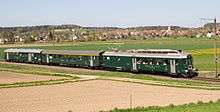
In the 19th century, all Swiss railways were owned by private ventures. The economic and political interests of these companies led to lines being built in parallel and some companies went bankrupt in the resulting competition. On 20 February 1898 the Swiss people agreed in a referendum to the creation of a state-owned railway company.
Later that year, the Federal Assembly approved the purchase of Schweizerische Centralbahn (SCB) to operate trains on behalf of the federal government. The first train running on the account of the Swiss Confederation ran during the night of New Year's Eve 1900/New Year's Day 1901 from Zurich via Bern to Geneva, and received a ceremonial welcome upon arriving in Bern. SBB's management board was first formed in mid-1901, and added Schweizerische Nordostbahn (NOB) to the system on 1 January 1902. This date is now observed as the "official" birthday of SBB.[11]
The following railway companies were nationalised:
- Aargauische Südbahn (ASB)
- Bötzbergbahn (BöB)
- Schweizerische Nordostbahn (NOB)
- Schweizerische Centralbahn (SCB)
- Toggenburgerbahn (TB)
- Vereinigte Schweizerbahnen (VSB)
- Tösstalbahn including the Wald-Rüti Railway (WR)
- Wohlen-Bremgarten Railway (WB)
- Jura-Simplon-Bahn (JS) including the Brünigbahn (the latter in 1903)
Other companies were included later, and the rail network was extended. It is still growing today.
On 1 January 1999 the Swiss Federal Railway has been excluded from the Federal Administration and became a fully state-owned (the federal state owns 100% of all shares) limited company regulated by public law (German: öffentlich-rechtliche Aktiengesellschaft).
First class compartments were discontinued on 3 June 1956, and second and third class accommodation was reclassified as first and second class, respectively.
In 1982 SBB introduced the Taktfahrplan ("clockface timetable"), with trains for certain destinations leaving every 60 minutes, greatly simplifying the timetable.
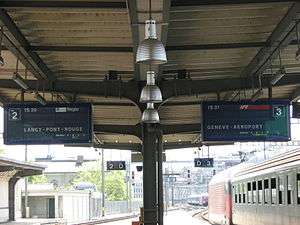
On 12 December 2004 the first phase of Bahn2000, an ambitious programme to improve the company's services, was put into effect.[12] The core element was the Zurich-Bern-Basel triangle, where travel times between the cities was reduced to under one hour, resulting in good connections from these stations for most trains. Some connections between cities got two trains in each direction per hour or more, and the S-Bahn services were intensified to four or more trains per hour. Because of these changes 90% of the timetable was changed, 12% more trains were scheduled and travel times generally improved. It was the greatest timetable change since the introduction of the Taktfahrplan.
For this change to be possible, large parts of the infrastructure had to be modified and many stations were rebuilt, for instance the line from Ziegelbrücke to Sargans or Bern main station which got the "wave of Bern", a platform over the tracks to provide better access to the platforms and the city centre.
On 22 June 2005 a short circuit on a long distance power transmission line in central Switzerland led to a chain reaction. The entire Swiss railway network was out of service during rush hour and an estimated 200,000 people and 1,500 trains were stuck at stations or somewhere on the track. It turned out that the SBB power transmission network was overloaded and did not provide enough redundancy to tolerate the shutdown of the four cable Amsteg-Steinen power line due to construction work. So, the power grid was split in two parts, the northern half being overloaded and the southern half having a load reduction for the SBB power plants are situated in the southern part (the Alps), while most of the power is needed in the northern part (the Swiss plateau). The situation led to high voltage fluctuations and finally breakdown and emergency shutdown of the entire power supply.
In the same year, the Swiss Federal Railways received the Wakker Prize, an award given out by the Swiss Heimatschutz (an institution aiming to preserve significant buildings), which is usually only granted to communes, for their extraordinary efforts. The Swiss Federal Railways have many listed buildings from well-known architects such as Herzog & de Meuron, Santiago Calatrava, and Max Vogt.
In May 2010, SBB's first integrated network control centre opened in Lausanne, to supervise all of SBB's network in the French-speaking part of Switzerland. Another integrated control centre will be opened in Zurich.[13]
All trains and most buildings have been made non-smoking since the timetable change of 11 December 2005.
By the end of 2006, the corporation was handed over from the long-term CEO Benedikt Weibel to his successor Andreas Meyer.
On 13 January 2019, Bloomberg reported that SBB was in talks with German aviation company, Lilium to create air taxis to carry customers from train stations to their final destination.[14]
Clock
The Swiss Federal Railways clock designed by Hans Hilfiker has become a national icon.[15] It is special in that it stops for just over a second at the end of each minute, to wait for a signal from the master clock which sets it going again — thus keeping all station clocks synchronised.[16][17]
On 20 September 2012, Swiss and world media reported that the design of this clock had been copied without prior permission by Apple Inc. and used in the iOS 6 clock application on Apple devices.[18] The issue was settled with Apple paying the Swiss Federal Railway service about 20 million Swiss Francs for its use of the clock design.[19]
Rolling stock
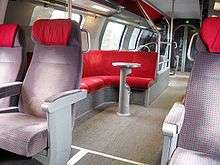
Mainline locomotives
Steam engines of the early days of the Swiss Federal Railways were, among others, the Ed 2x2/2, E 3/3, A 3/5, B 3/4 and C 5/6.
The first electric trial runs using single-phase alternating current were made in 1903 on the line Seebach – Wettingen together with the Maschinenfabrik Oerlikon (MFO), using the future Ce 4/4 locomotives ("Eva" and "Marianne"). The electrification of the network started 1919, motivated by the coal shortages during the First World War, and new electric locomotives were introduced: Ce 6/8 II/Ce 6/8 III "Crocodile" (1920/1926), Be 4/6 (1920), Be 4/7 (1921), Ae 3/6 I (1921), Ae 3/6 II (1924), Ae 3/6 III (1925), Ae 4/7 (1927) and Ae 4/6 (1941). A shift of paradigms happened in 1946, when the age of modern bogie-based locomotives without trailing axles started with the Re 4/4 I (1946), followed by the Ae 6/6 (1952), Re 4/4 II/Re 4/4 III (1964/1971), Re 6/6 (1972), Re 450 (1989) and Re 460/Re 465 "Lok 2000" (1992/1994).
The delivery of the last Re 465 marked the end of the Swiss locomotive industries with the closure of the Swiss Locomotive and Machine Works. The Swiss Federal Railways were split into three divisions: Passenger, Freight and Infrastructure, each with independent locomotive supply policies. Because the Passenger division got all modern Re 460s and opted for multiple unit trains, mainline locomotives were bought only by the Cargo division, namely Re 482 "Traxx F140 AC" (2002), Re 484 "Traxx F140 MS" (2004) and Re 474 "ES64 F4" (2004).
Multiple units
The first multiple units originated from the Seetalbahn, which was formed in 1922. Larger series were uncommon until after 1950: Be 4/6 (1923), De 4/4 (1927), BDe 4/4 (1952), RBe 4/4 (1959), RBDe 560 "NPZ" (1984) and RABe 520 "GTW" (2002).
The first multiple unit trainsets were bought for the introduction of the Taktfahrplan on the line Zurich–Meilen–Rapperswil in 1967: RABDe 12/12 "Mirage" (1965) and RABDe 8/16 "Chiquita" (1976). Multiple unit trainsets started to prevail in the 1990s, especially for commuter traffic: RABDe 500 "ICN" (1999), RABe 523 (et al.) "FLIRT" (2004), RABe 514 "DTZ" (2006), and RABe 503 (2008). While locomotive-hauled trains are rarely seen in commuter traffic nowadays, they are still the usual in intercity traffic. In 2011, Stadler's RABe 511 were introduced in Zurich's S-Bahn and in 2012 was introduced as a Regional Express between Geneva and Romont and Geneva and Vevey and Bern and Biel.
Some of the most popular historic multiple unit trainsets are the Roten Pfeile ("Red Arrows") (RAe 2/4) and the "Churchill-Pfeil" (RAe 4/8). In international traffic the Trans-Europ-Express (TEE) diesel trainsets appeared in 1957, but were replaced by four-systems electric trainsets RAe TEEII in 1961.
On 12 May 2010, the Swiss Federal Railways announced its largest order of rolling stock; buying 59 double-deck EMUs (Twindexx) from Bombardier, plus an option for another 100 trainsets. The new trains were originally intended to be delivered starting in 2012, but due to several delays, deliveries began in 2017 and end by 2020.[20][21]
In addition, SBB has received and, as of 2016, is still in the process of delivering, New Pendolinos[22][23] and has ordered 29 SMILEs, with an option for 92 more, expected to enter service in 2019.[24]
Languages
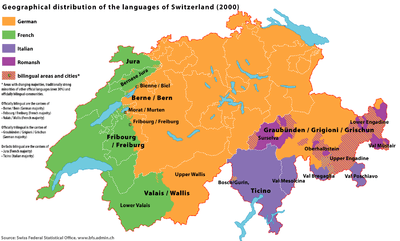
SBB uses three official languages. The Romansh-speaking canton of Grisons of Switzerland is served mostly by the RhB. Stations are named usually with the abbreviation corresponding to and signposted exclusively in the language of the locality: Basel SBB, Lausanne CFF, Bellinzona FFS. Trains are branded "SBB CFF FFS".
Announcements in stations are made in local languages, the announcement jingle is also different in each part of the country. On board of national trains welcome announcements are made in German, English and any other local language. Then the stops are announced in the local language of the town with the exception of big hubs where the train driver takes the microphone to announce in the local language and English that the train is arriving, if the train is on time or not, and next connections at the station. Announcements for local trains are made in the local language. Long-distance trains at major stations also have announcements in English if there are many foreign travelers or in tourist regions (i.e., Zurich Airport, Interlaken, Aigle, etc.)
Services
Train services
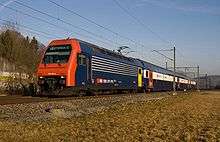
SBB has the following services:[25]
- R: Regio (Regionalzug): stops at all stations
- S: S-Bahn (commuter train): organized as a rapid transit system in major agglomerations, with several lines and generally high frequent service.
- RE: RegioExpress: local trains to access within a region.
- IR: InterRegio: are the workhorses of Swiss transit. They reach across two or three cantons, for instance from Geneva, along Lake Geneva through Vaud, and all the way to Brig at the far end of the Valais.
- IC: InterCity: stops at major cities (Geneva, Lausanne, Fribourg etc.). For the 2017/18 timetable, the SBB gave numbers to all IC and IR lines.
- ICN: InterCity Tilting Train Similar to the IC, but using tilting trains instead of standard/double-decked trains. The ICN designation was discontinued as of 10 December 2017, with former ICN services now being branded as IC, but still run by tilting trains.
EXT: Charter train or special train added when an exceptionally heavy traffic is expected.
Regional trains are sometimes operated by another Swiss railways operator (for example, the Bern S-Bahn services operated by the BLS AG.)
SBB also operates international EuroCity and EuroNight trains while within Switzerland, while Deutsche Bahn operates InterCityExpress services to, from, and (a few services) within the country serving Swiss cities such as Interlaken, Bern, Basel, Zürich, and Chur. Under the name TGV Lyria the French railway company SNCF operates TGV connections to Switzerland. Lyria SAS, a company established under French law, is a subsidiary of the Société Nationale des Chemins de Fer Français (SNCF – French National Railway Company) which owns 74%, and the Chemins de Fer Fédéraux Suisses (CFF – Swiss Federal Railways) which owns 26%. TGV Lyria serves several Swiss cities including Geneva, Lausanne, Basel, Zürich, Bern, and Interlaken. It also provides services to certain locations including Brig in the Valais especially during the winter season to provide a connection for tourists mainly visiting the south-eastern Swiss Alps. These connections are marketed under the name of TGV Lyria des Neiges.[26]
Lines
In 2018, the SBB gave numbers to all IC and IR lines (like a subway network) to ease connections. The lines are:
InterCity :
- IC 1 Genève-Aéroport - Lausanne - Fribourg/Freiburg - Bern - Zürich HB - Zürich Flughafen - Winterthur - St.Gallen
- IC 2 Zürich HB - Zug - Arth-Goldau - (Flüelen) - Bellinzona - Lugano
- IC 3 Basel SBB - Zürich HB - Sargans - Landquart - Chur
- IC 4 Zürich HB - Schaffhausen
- IC 5 Genève-Aéroport - Genève - Morges (Lausanne, other End Station) - Yverdon-les-Bains - Neuchâtel - Biel/Bienne - Grenchen-Süd - Solothurn - Oensingen - Olten - Aarau - Zürich HB - Zürich Flughafen - Wil - Uzwil - Flawil - Gossau SG - St.Gallen
- IC 6 Basel SBB - Olten - Bern - Thun - Spiez - Visp - Brig
- IC 8 Brig - Visp - Spiez - Thun - Bern - Zürich HB - Zürich Flughafen - Winterthur - Frauenfeld - Weinfelden - Amriswil - Romanshorn
- IC 21 Basel SBB - Olten - Luzern - Arth-Goldau - (Flüelen) - Bellinzona - Lugano
- IC 51 Basel SBB - Laufen - Delémont - Moutier - Grenchen-Nord - Biel/Bienne
- IC 61 Basel SBB - (Liestal) - Olten - Bern - Thun - Spiez - Interlaken West - Interlaken Ost
InterRegio :
- IR 13 : Zürich HB - Oerlikon - Flughafen - Winterthur - Wil SG - Uzwil - Flawil - Gossau SG - St Gallen - Rorschach - St Margrethen - Heerbrugg - Altstätten - Buchs SG -Sargans - Bad Ragaz - Landquart - Chur
- IR 15 : Genève-Aéroport - Genève - Nyon - Morges - Lausanne - Palézieux - Romont - Fribourg/Freiburg - Bern - Zofingen - Sursee - Luzern
- IR 16 : Bern - Olten - Aarau - Brugg AG - Baden - Zürich HB
- IR 17 : Bern - Burgdorf - Wynigen - Herzogenbuchsee - Langenthal - Olten (- Zürich HB)
- IR 26: Basel SBB - Olten - Luzern - Arth-Goldau - Schwyz - Brunnen - Flüelen - Erstfeld (- Göschenen)
- IR 27: Basel SBB - Liestal - Sissach - Geltenkinden - Olten - Zofingen - Sursee - Luzern
- IR 36 : Basel SBB - Rheinfelden - Stein-Säckingen - Brugg AG - Baden - Dietikon - Zürich Altstetten - Zürich HB (- Zürich Oerlikon - Zürich Flughafen)
- IR 37 : Basel SBB - Liestal - Sissach - Aarau - Lenzburg - Zürich HB - Zürich Flughafen - Winterthur - Wil SG - Gossau SG - St.Gallen
- IR 46 : Zürich HB - Zug - Arth-Goldau - Schwyz - Brunnen - Flüelen - Erstfeld (- Göschenen)
- IR 70 : Luzern - Rotkreuz - Zug - Baar - Thalwil - Zürich HB (- Zürich Oerlikon - Zürich Flughafen)
- IR 75 : Zürich HB - Zürich Flughafen - Winterthur - Frauenfeld - Weinfelden - Kreuzlingen - Konstanz
- IR 90 : Genève-Aéroport - Genève - (Nyon - Morges) - Lausanne - Vevey - Montreux - Aigle - Bex - St Maurice - Martigny - Sion - Sierre/Siders - Visp - Brig
Regio Express:
- Re : Genève - Versoix - Coppet - Nyon
- RE : Genève - Coppet - Nyon - Gland - Allaman - Morges - Renens VD - Lausanne - Vevey
- RE : Bern - Lyss - Biel/Bienne
- RE : Zürich HB - Zürich Oerlikon - Bülach - Schaffhausen
- RE : Aarau - Lenzburg - Zürich HB
- RE : Chur - Landquart - Bad Ragaz - Sargans - Walenstadt - Ziegelbrücke - Siebnen-Wangen - Pfäffikon SZ - Wädenswil - Thalwil
- RE : Erstfeld - Göschenen - Airolo - Ambri-Piotta - Faido - Lavorgo - Bodio TI - Biasca - Castione-Arbedo - Bellinzona - Giubiasco - Lamone-Cadempino - Lugano - Mendrisio - Chiasso (- Milano)
- RE : Bern - Burgdorf - Wynigen - Herzogenbuchsee - Langenthal - Olten
- RE : Wil - Uzwil - Flawil - Gossau SG - St. Gallen - Rorschach - St. Margrethen - Heerbrugg - Altstätten SG - Buchs SG - Sargans - Bad Ragaz - Landquart - Chur
Customer services
SBB offers additional services for customers.[27] SBB Digital promotes new digital services for customers. For example, SBB started a collaboration with Uber,[28] with the recruiting matchmaking service, Jacando,[29] and their own co-working space in Zurich.[30] SBB has won CRM awards in Switzerland for their SBB Digital activities.[31]
Airline codeshare
- SBB codeshares with American Airlines, Swiss International Air Lines, and United Airlines out of Zurich Airport.
See also
Notes and references
Notes
- Not used.
References
- "We are SBB". Bern, Switzerland: SBB CFF FFS.
- Tyler Brûlé (30 March 2012). "On track to beat the Monday blues". Financial Times.
- "SBB calls tenders for Gotthard high speed trains". Railway Gazette International. London: DVV Media UK Ltd. 17 April 2012.
- "the 2017 European Railway Performance Index". Boston Consulting Group.
- "Infrastructures". SBB CFF FFS. 2018. Retrieved 21 July 2019.
- "Personnel". SBB CFF FFS. 2018. Retrieved 21 July 2019.
- "Transportation". SBB CFF FFS. 2018. Retrieved 21 July 2019.
- "Quality". SBB CFF FFS. 2018. Retrieved 21 July 2019.
- "Rolling Stock". SBB CFF FFS. 2018. Retrieved 21 July 2019.
- SBB history page
- Murray Hughes (1 May 2005). "Bahn 2000 is working". Railway Gazette International.
- "Supervising Swiss tracks". Railway Gazette International. 26 June 2010. Retrieved 21 July 2010.
- Hoffman, Andy (13 January 2019). "Swiss Rail Service Planning Electric Flying Taxis: Report". Bloomberg. Retrieved 20 January 2019.
- "Remarkable clocks and watches: the Swiss railway clock". swissworld.org. Bern: Presence Switzerland, Swiss Federal Department of Foreign Affairs FDFA. Retrieved 11 December 2014.
- Köbi Gantenbein, ed. (2013). Die Bahnhofsuhr – Ein Mythos des Designs aus der Schweiz (in German). Zurich: Edition Hochparterre. Archived from the original on 4 November 2014. Retrieved 19 October 2014.
- "Mobetime – Swiss Time Systems: References". MOSER-BAER SA. Sumiswald, Bern. Retrieved 19 October 2014.
- "Apple kopiert die berühmte SBB-Uhr". Tages-Anzeiger (in German). Zurich. 11 November 2012. Retrieved 11 December 2014.
- Adrian Sulc (20 September 2012). "Der Streit mit Apple schwemmt Millionen in die SBB-Kasse". Tages-Anzeiger (in German). Zurich: TA Media AG. Retrieved 11 December 2014.
- "Bombardier réclame des centaines de millions aux CFF" [Bombardier claims for several hundreds of millions of francs from the SBB]. 24 Heures (in French). 22 January 2014. Retrieved 15 August 2014.
- "SBB Approves Pre-Series Twindexx EMU". Railway Gazette International. 11 June 2015. Retrieved 14 July 2016.
- "SBB Orders More ETR610 Tilting Trains". Railway Gazette International. 2 February 2015. Retrieved 14 July 2016.
- "ETR610 Arrives in Switzerland". Railway Gazette International. 28 June 2014. Retrieved 14 July 2016.
- "SBB's First Giruno Cars Take Shape". Railway Gazette International. 8 July 2016. Retrieved 14 July 2016.
- "SBB: Train identification". Swiss Federal Railways. 2014. Retrieved 15 August 2014.
- "TGV Lyria Network". Lyria SAS. 2013. Retrieved 15 August 2014.
- "SBB customer service". sbb.ch. 2014. Retrieved 11 July 2014.
- "SBB wollen Uber-Taxis testen". Blick (in German). 2014. Retrieved 11 July 2014.
- "SBB werden zum Nebenjob-Vermittler". 20 Minuten (in German). 2014. Retrieved 11 July 2014.
- "Silicon Bahnhof - SBB Co-Working Space". Handelszeitung (in German). 2014. Retrieved 11 July 2014.
- "Gewinner Innovation". Swiss CRM Institute AG (in German). 2014. Retrieved 11 July 2014.
External links
| Wikimedia Commons has media related to SBB-CFF-FFS. |
- English SBB website
- The SBB cargo website
- The CityNightLine website in German, Dutch, or English
- Hans-Peter Bärtschi: Federal Railways in German, French and Italian in the online Historical Dictionary of Switzerland, 2012-11-27.
